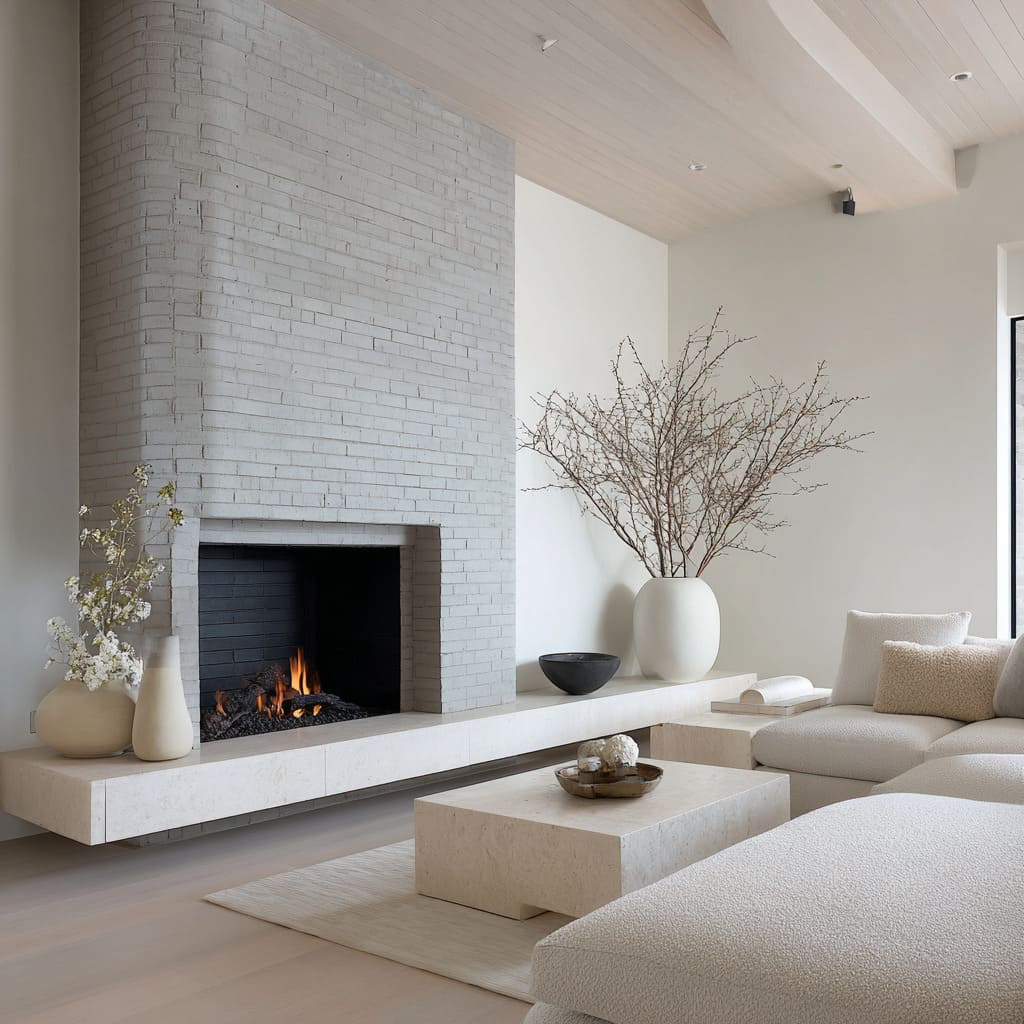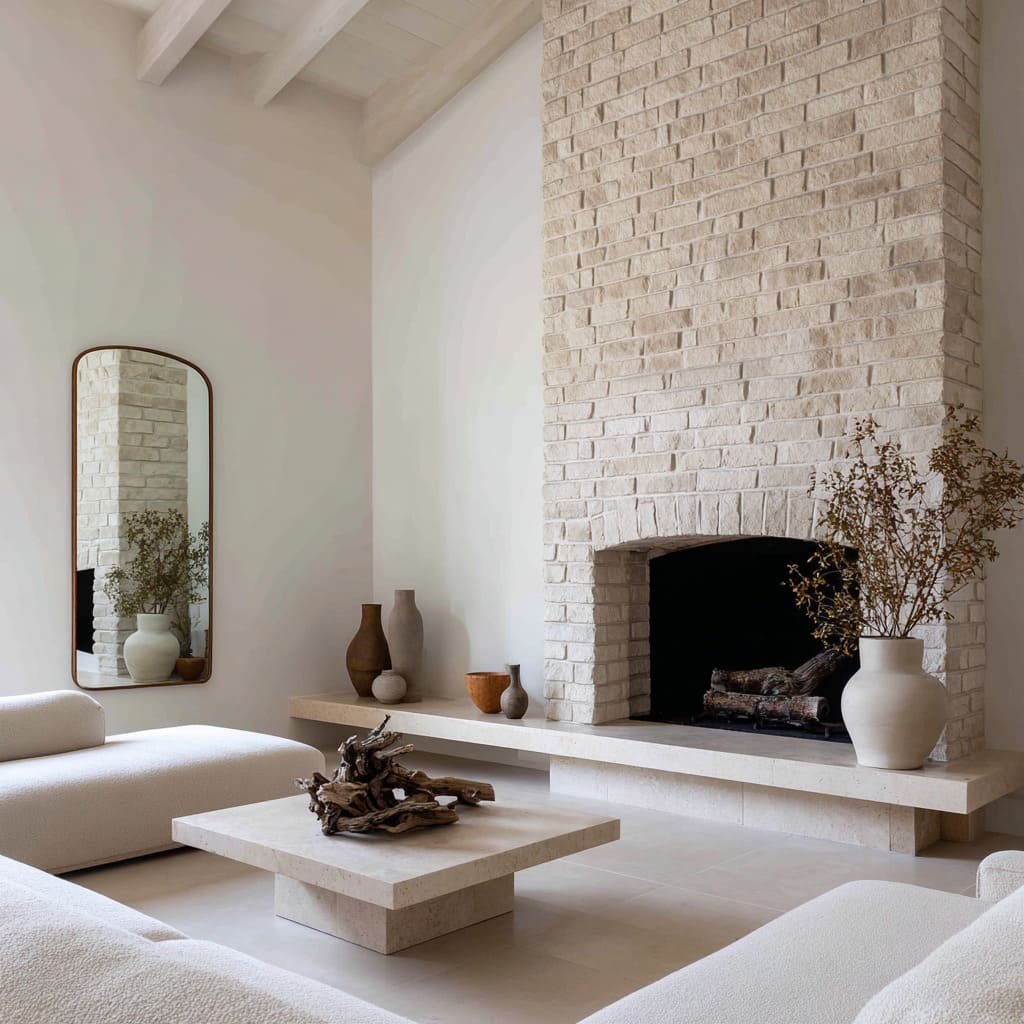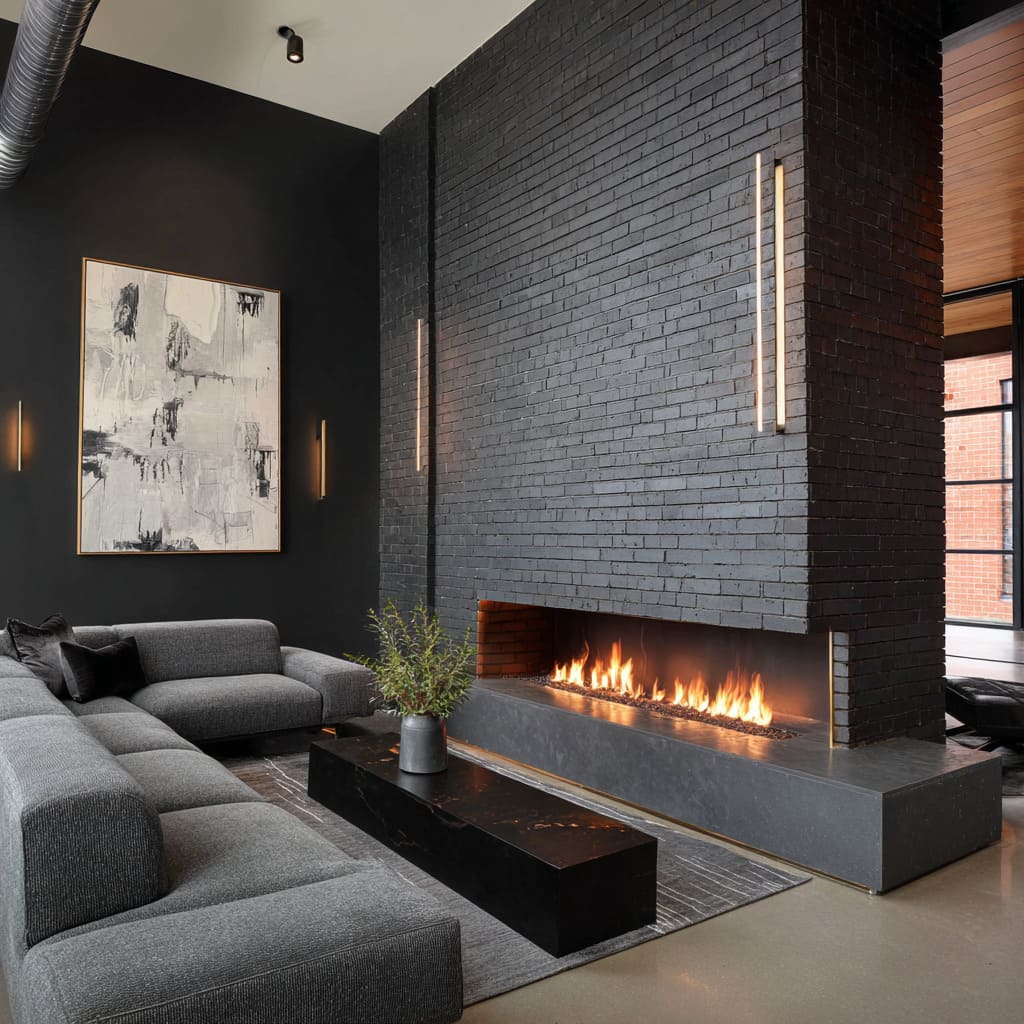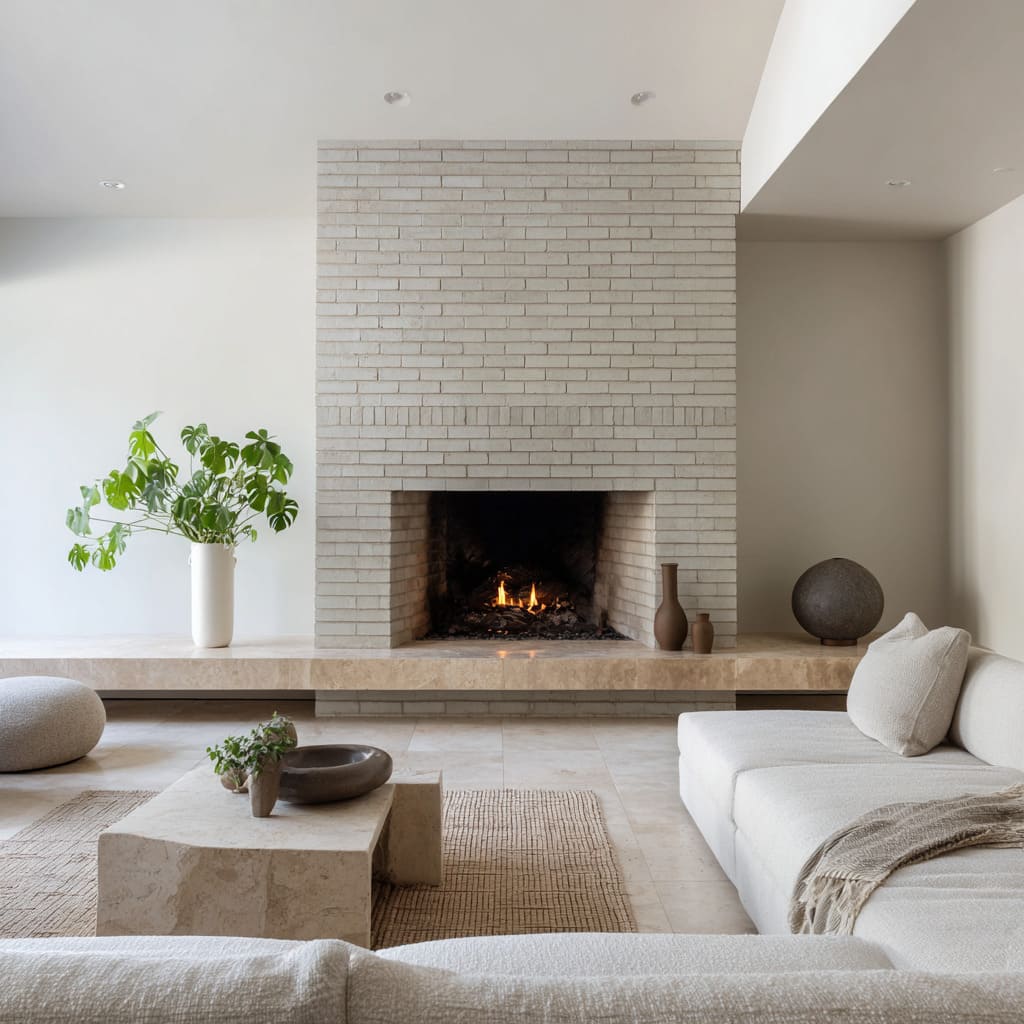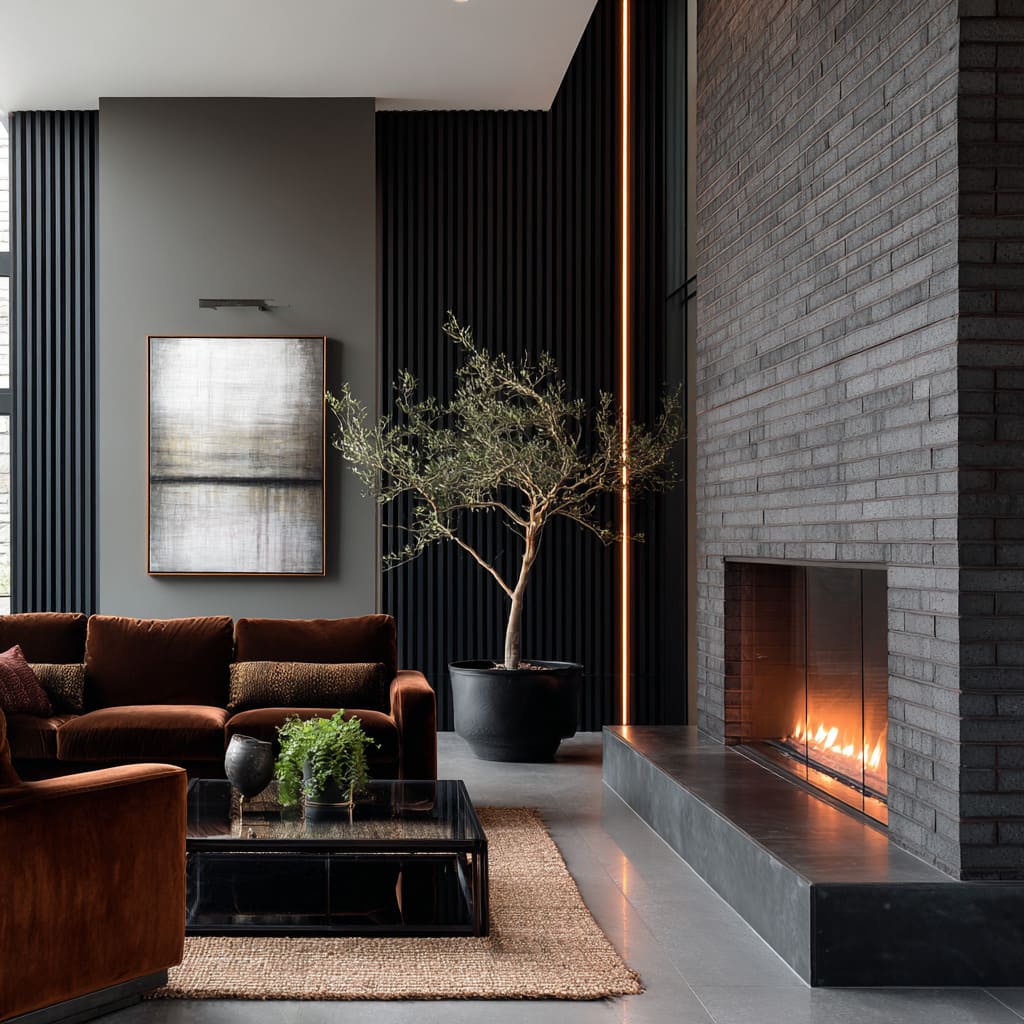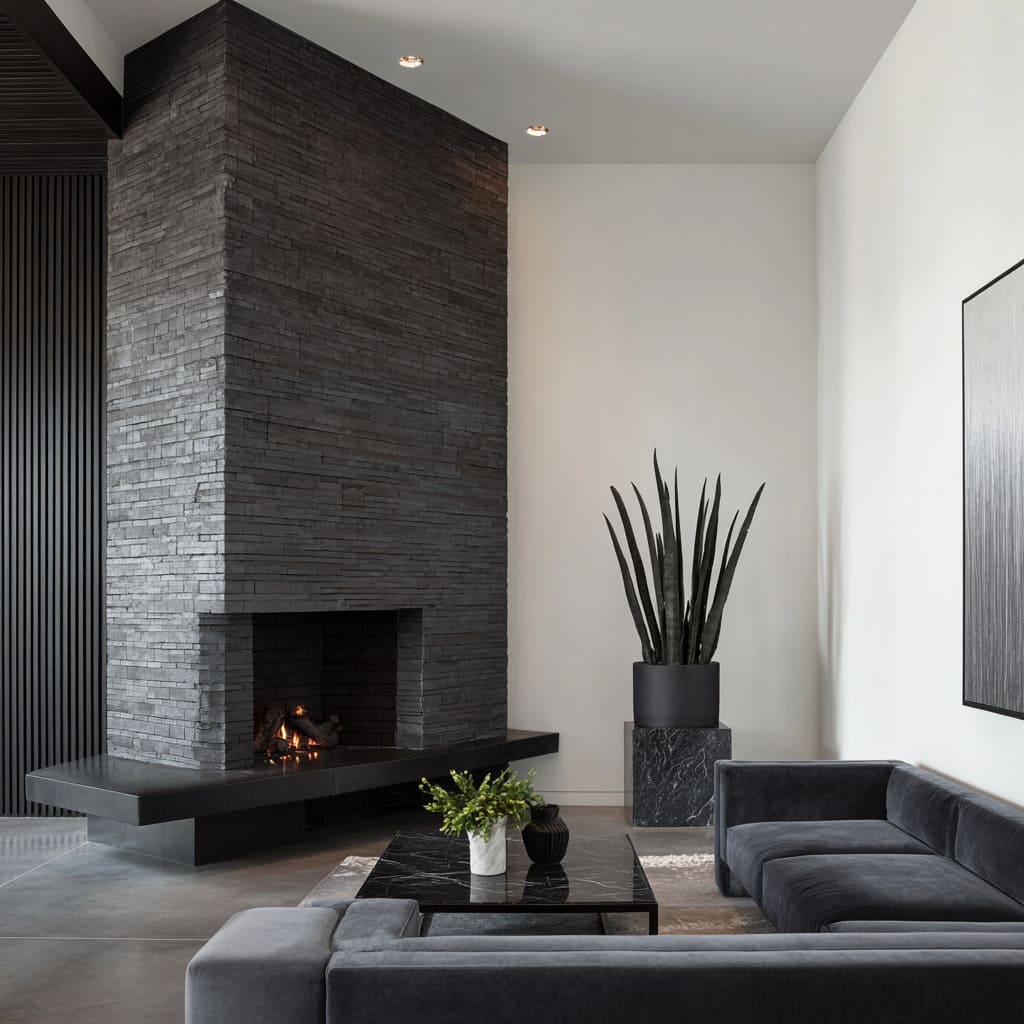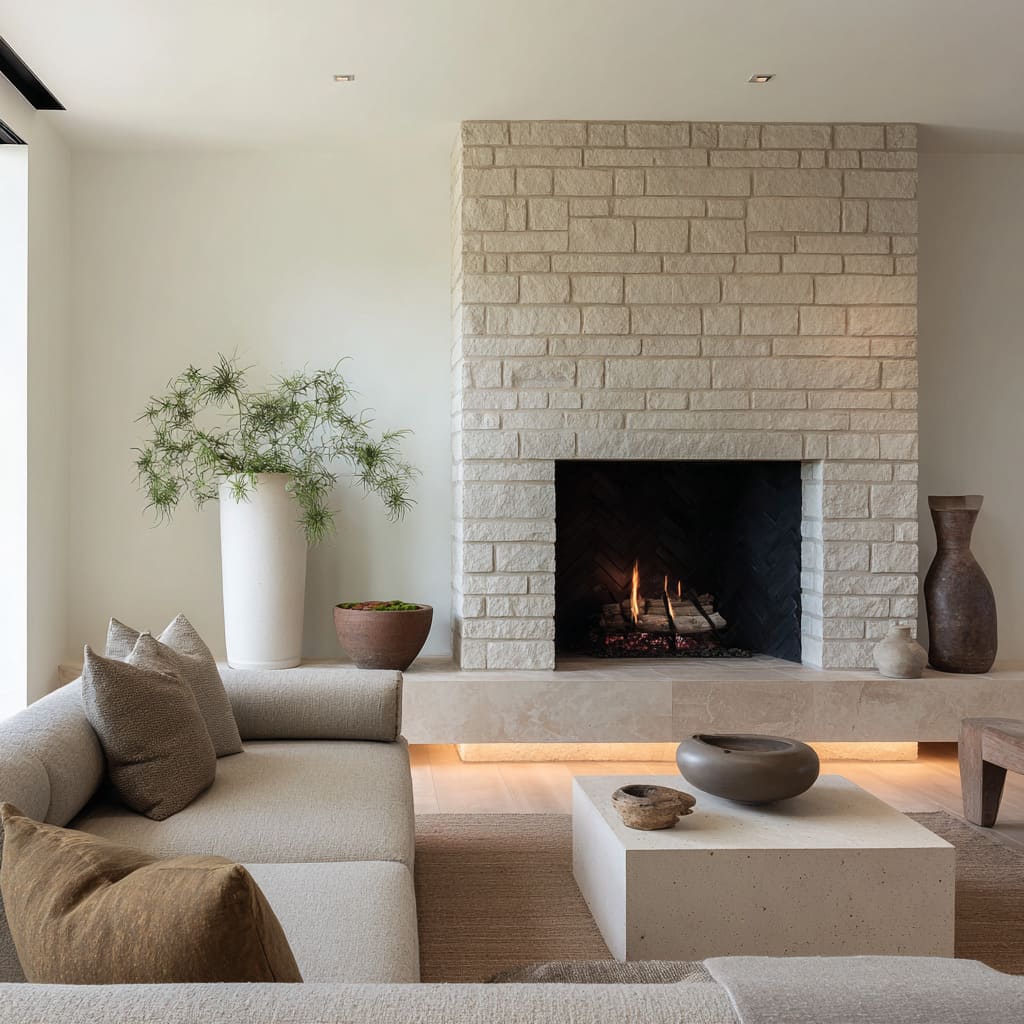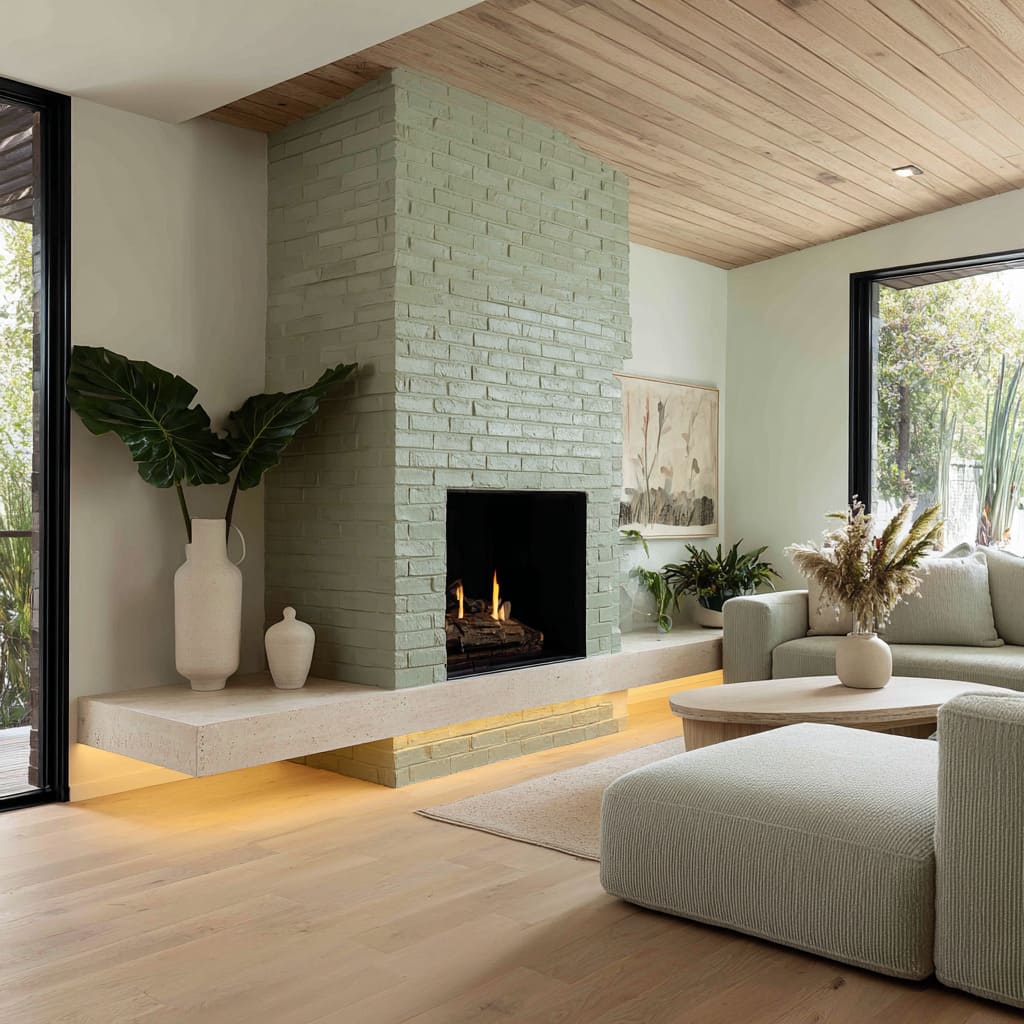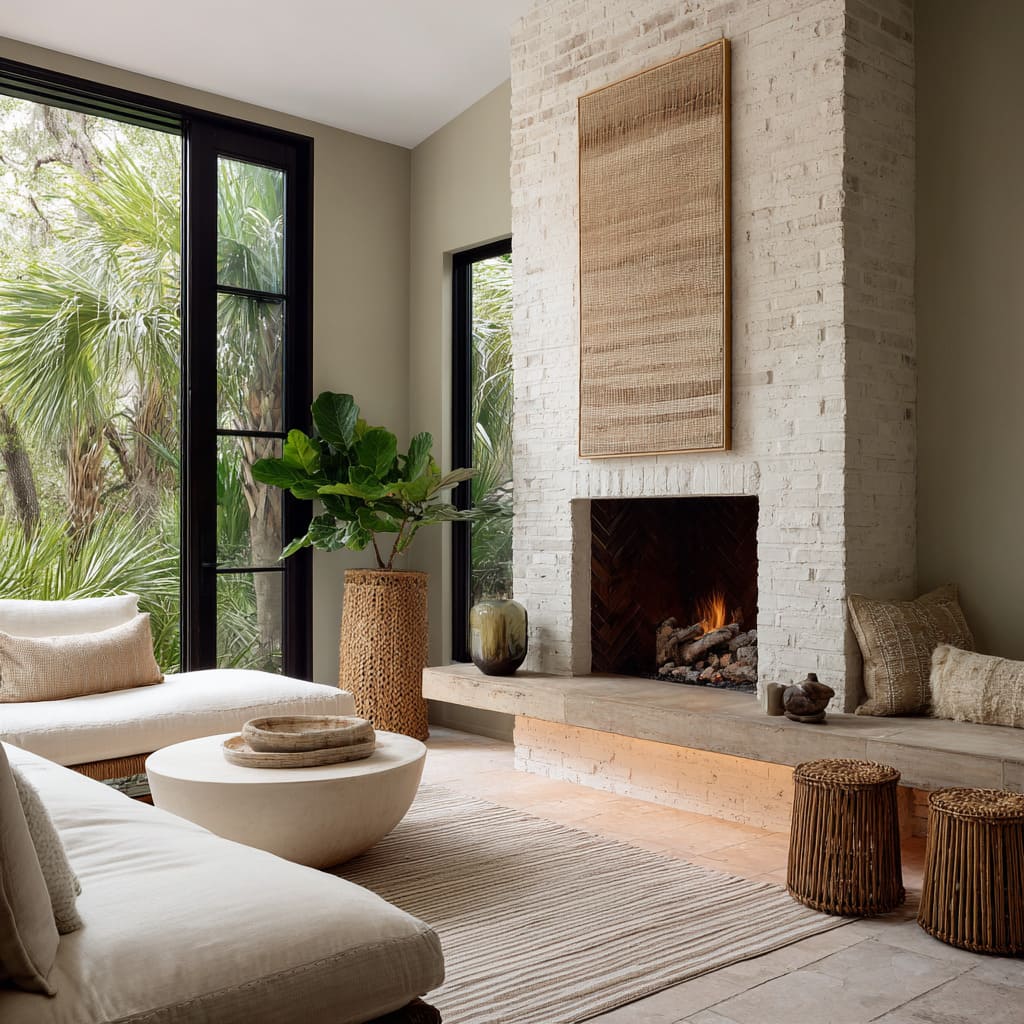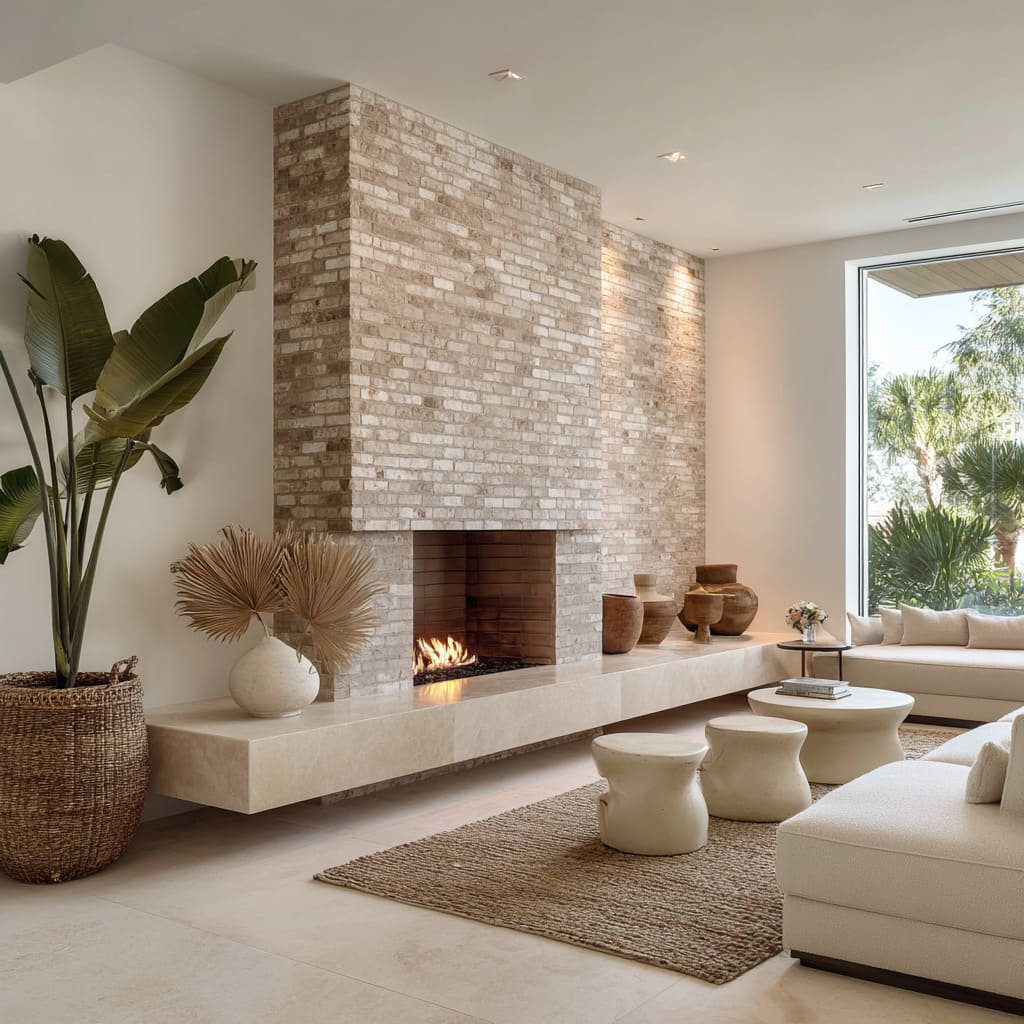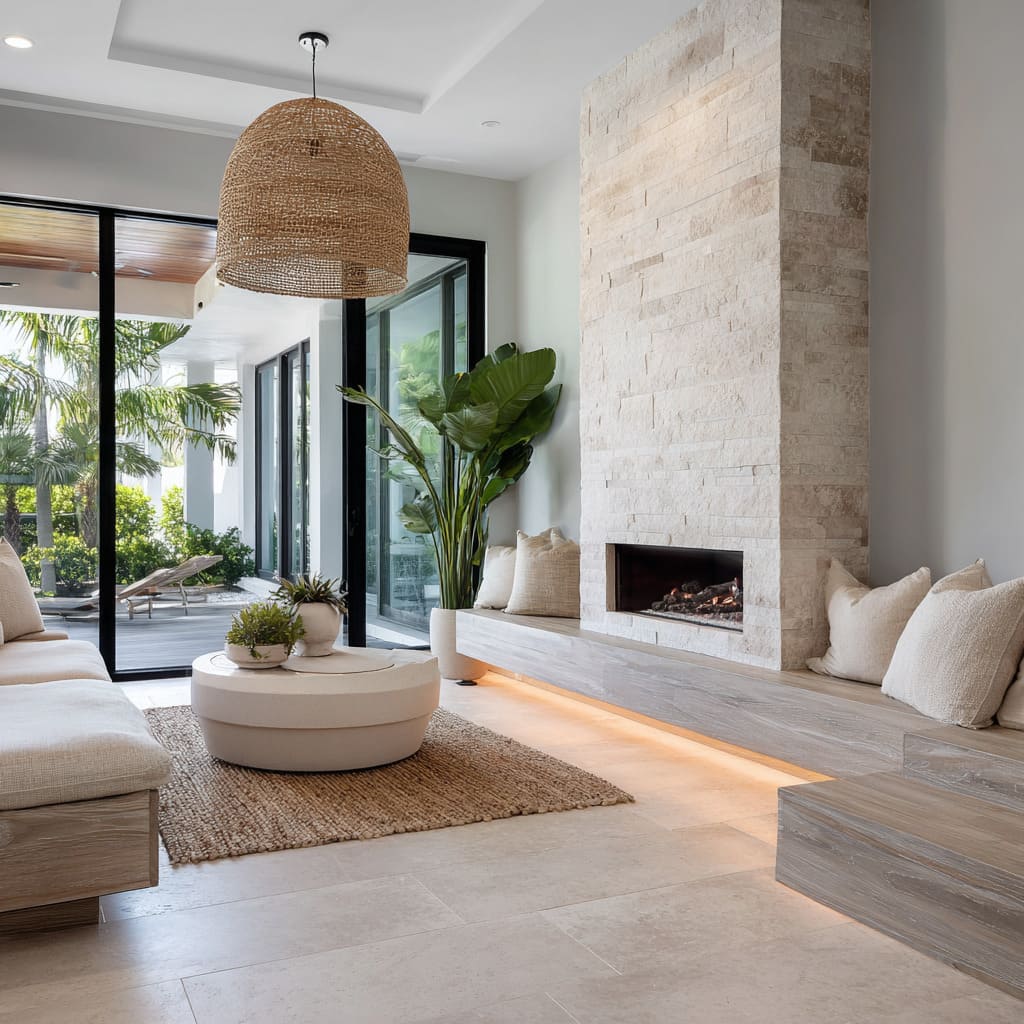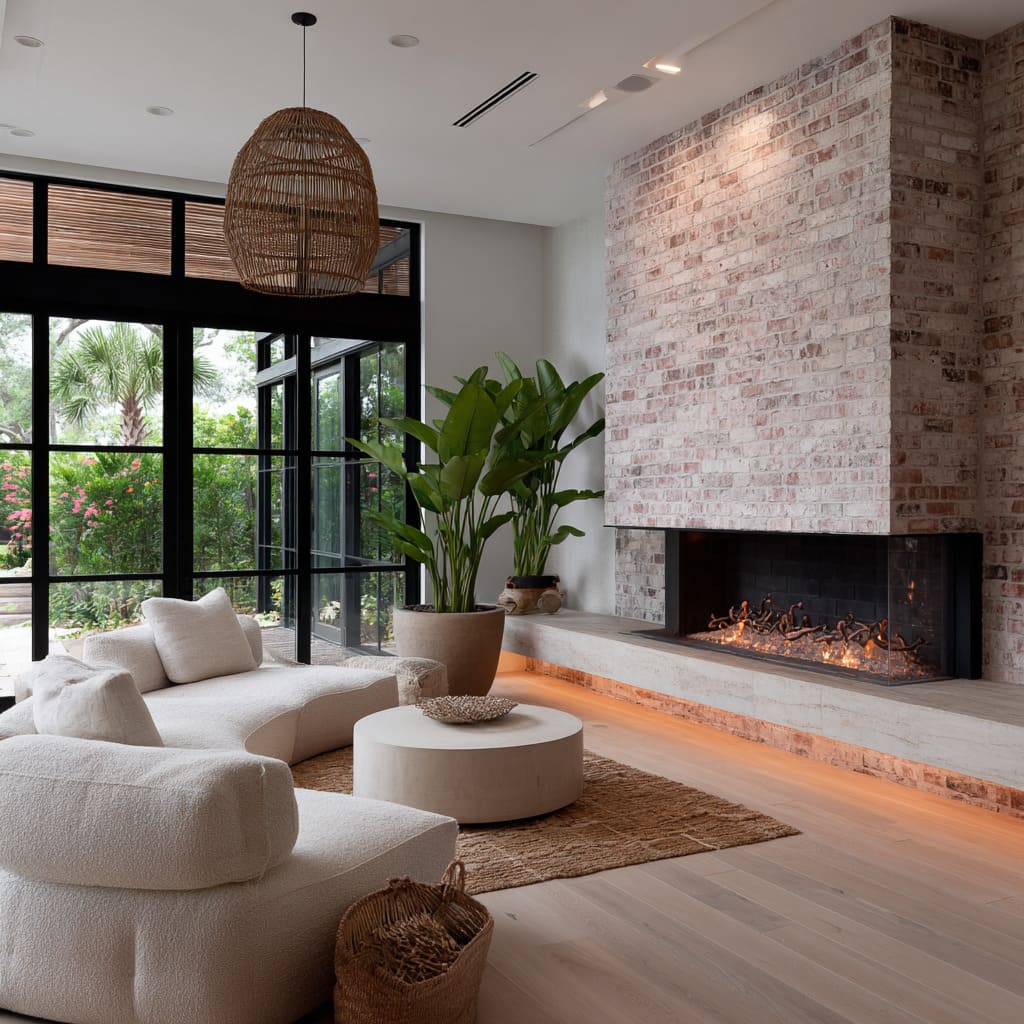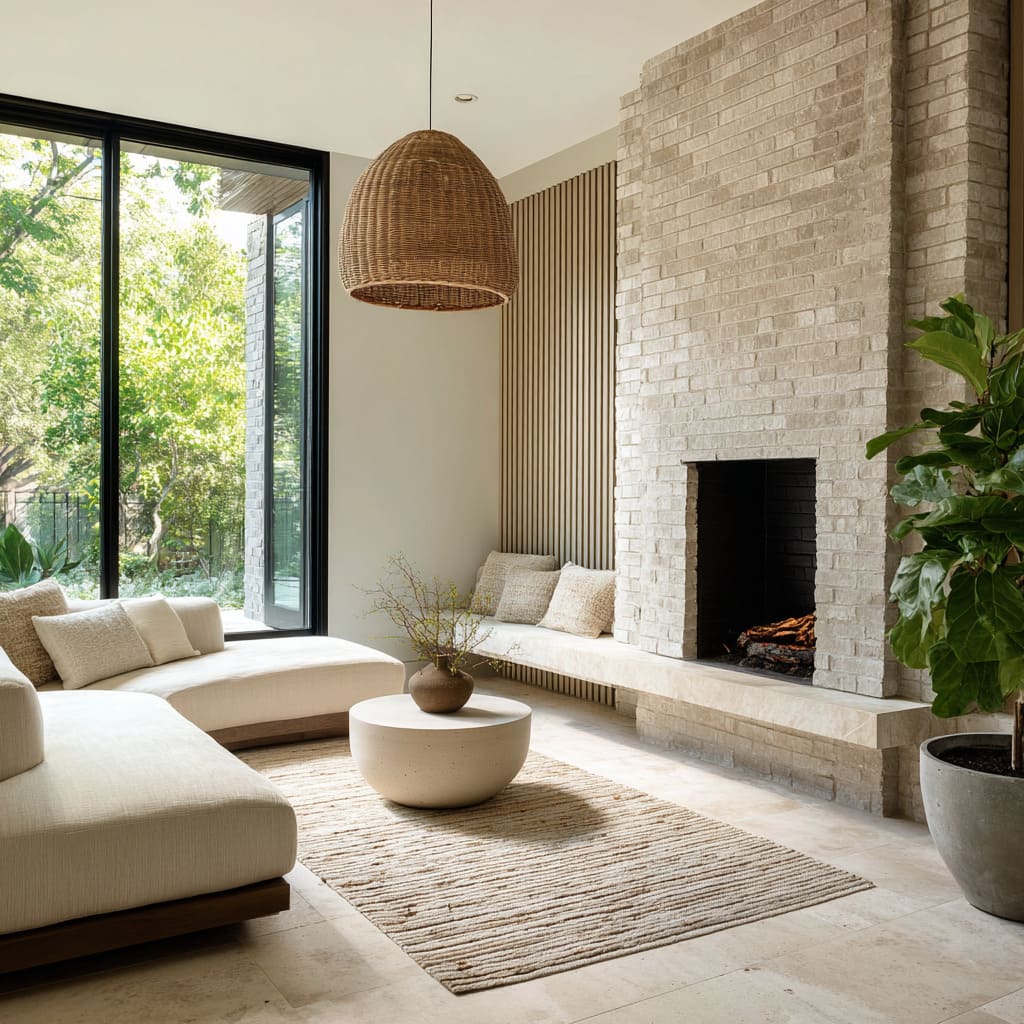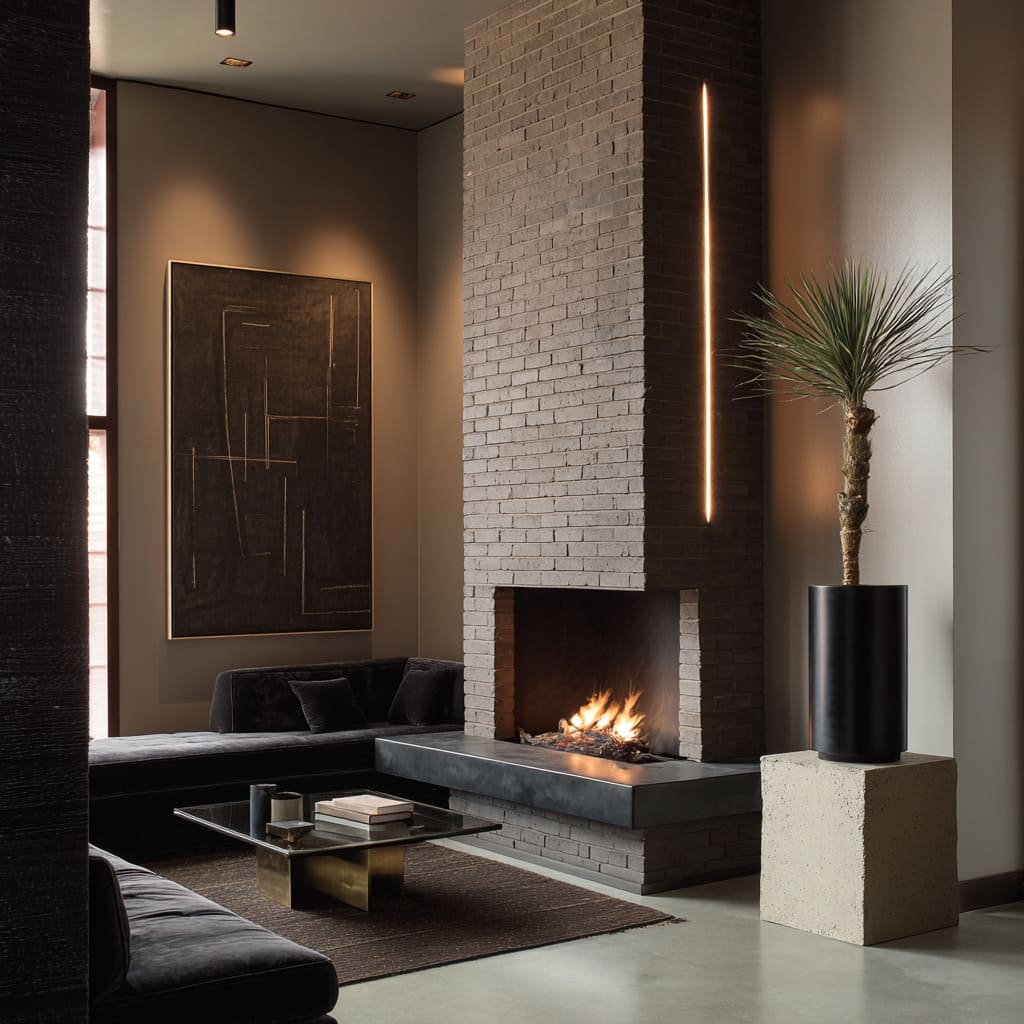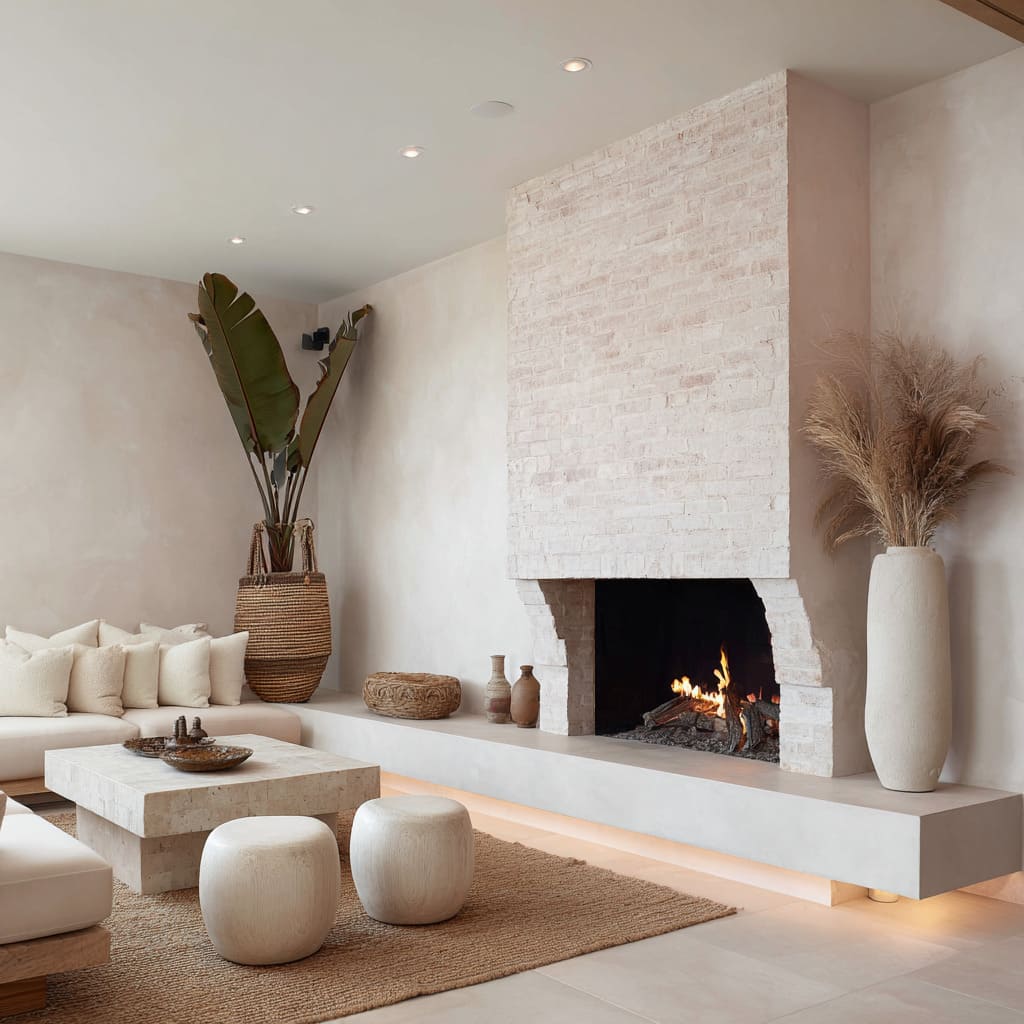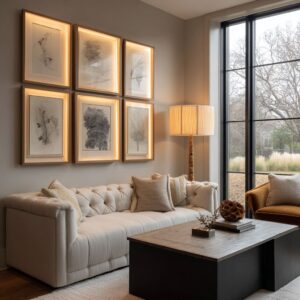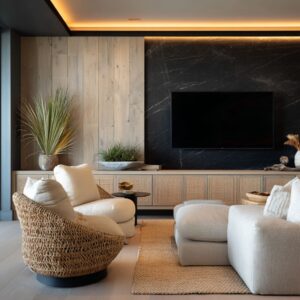The way fireplaces are shaped today moves far beyond simple function. Modern brick fireplace design has shifted into a study of proportion, surface control, and visual rhythm, where every small decision quietly shapes the entire space.
Materials are softened, volumes are carefully balanced, and texture is managed with remarkable precision. The fire no longer acts only as a heat source but serves as the visual anchor around which the entire room composition takes form.
Subtle color shifts, exacting symmetry breaks, and carefully placed organic elements work together to build spaces that feel both controlled and natural. Lighting is integrated with surgical detail, floating hearths provide lightness to heavy forms, and even the furniture responds to the architectural mass.
This approach allows fireplaces to blend with modern interiors in ways that feel deliberate but never forced, reflecting a deeper level of design thinking that defines many current trends.
Surface Control
One of the defining traits in modern brick fireplace design is the restraint shown in surface texture. While traditional brickwork often leans into coarse finishes and bold joints, these newer interpretations operate on a much quieter level.
Texture is allowed to exist — but only just enough to be felt, not shouted. In many of the most forward-looking modern brick fireplace ideas, grout lines are razor-thin.
The narrow spacing eliminates any visual clutter, keeping the rhythm of the brick uninterrupted and clean. This reduction of excess visual information shifts the fireplace from a traditional building element into a subtle sculptural form.
To soften transitions between materials, whitewashed and sand-worn finishes are frequently used. These surface treatments mute the natural contrast between mortar and brick, letting the color blend in a smoother flow.
Even bricks with inherent irregularity begin to take on the look of soft clay, textile, or weather-polished stone. What’s most striking is how the texture never overwhelms the viewer.
Instead, it works like a second skin — adding visual depth without becoming rough or rustic. These finishes flatten the surface slightly, making even coarse materials feel refined.
The outcome is a wall that reads as deliberate and quiet, where the sense of form outweighs any roughness in detail.
Controlled Color Shifts
Rather than using high contrast or graphic color palettes, many of design ideas take cues from nature’s slow changes. Soft shifts in tone replicate the way stone changes color in different light conditions — from the warm blush of a sunlit rock to the dusty gray of old limestone.
This method is particularly visible in bricks that appear sun-bleached, coral-tinted, or clay-washed. The colors rarely look flat; they ripple subtly from one shade to the next, hinting at geological weathering.
Beige, pale rose, cool clay, or gray-taupe transitions unfold across surfaces that seem touched by years, not paint.
These restrained chromatic movements do more than simply create beauty — they allow the surface to reference natural formations without becoming literal. The effect suggests stone cliffs, coastal bluffs, or desert rocks without drawing attention to the source.
This approach gives modern brick fireplace ideas a grounded presence that doesn’t rely on bright pigment or artificial sheen. What results is a kind of visual calm, where materials feel aged in place rather than applied for effect.
Color becomes a quiet echo of the outdoors, working in soft gradients rather than dramatic shifts. It’s a finish style that stays modern by avoiding trend-chasing tones — choosing instead a layered look that feels timeless.
Negative Space: Absence Becomes Design
What’s missing becomes just as important as what’s built. Negative space is treated like a material — shaping the fireplace by leaving parts unfilled, unadorned, or deeply recessed.
One of the most noticeable uses of this is in horizontal ribbon fireboxes, where the flame seems to slice across the wall in a narrow cut. These long, low fire openings pull the focus laterally, balancing out the vertical bulk of the fireplace mass above.
Another recurring feature is the intentional depth of the firebox cavity. By recessing the opening and keeping the interior matte or dark, shadow becomes an active design layer.
The viewer’s eye is drawn into the void, which gives the surface additional dimensionality without any ornament.
Some of the most visually successful compositions place the firebox very low. This leaves a large span of material above it, which isn’t used for shelves or decoration — just empty form.
That empty area creates visual tension between weight and lightness, grounding the flame while letting the upper mass feel expansive. In many cases, the flame becomes the only source of color in a composition otherwise built on neutral tones.
This use of absence to frame energy is subtle but powerful. It draws attention not by adding elements, but by holding space around the few that remain.
Subtle Vertical vs Horizontal Rhythm Games
The most sophisticated modern fireplace designs are never one-directional in their geometry. Instead, they build an ongoing conversation between vertical and horizontal rhythm.
This creates movement across the surface, even in fully static materials. Horizontal brick coursing remains the backbone.
Each brick row stacks with absolute control, providing an underlying calm repetition that keeps the visual field steady. Yet this horizontal foundation gets interrupted by vertical gestures: tall slatted wood panels, recessed vertical light channels, or asymmetrical cuts.
These vertical insertions don’t disrupt the surface—they heighten its precision, carving through the horizontality like slender architectural marks.
Another key player in this balance is the floating hearth. Acting like a visual baseplate, it establishes a strong horizontal “horizon” line that anchors the tall fireplace mass above it.
The hearth’s thin floating effect amplifies the contrast between grounded weight and light elevation. Even the furniture responds to these rhythm games.
Low horizontal sectionals sit beneath towering chimney walls, while round ottomans or softly curved stools lean into vertical structures with their bulbous forms. This contrast between long planes and upright elements keeps the viewer’s eye moving without visual fatigue.
The result feels calm but never static — a careful oscillation between grounded presence and vertical lift. Through this quiet rhythm play, many interiors effortlessly make brick fireplace look modern while retaining visual softness.
The secret hides in this ongoing tension between stacked horizontal repetition and perfectly measured vertical intrusions.
Minimal Lighting Integration
Light here does not behave like decoration—it’s fully absorbed into the architecture. Lighting decisions are quiet but sharply calculated, serving to shape the mood rather than draw attention to fixtures themselves.
One of the most effective techniques involves vertical recessed light slits. These slim illuminated cuts are often embedded directly into the brick face, running tall and narrow alongside the chimney mass.
Their thinness echoes the scale of mortar joints, blending structural geometry with light composition. The light feels like an extension of the brick, not an applied fixture.
At the base, hearth underlighting creates a floating visual effect, detaching the hearth slab from the floor beneath it. This soft glow provides lift to otherwise heavy elements, allowing mass and lightness to coexist.
Above, indirect recessed ceiling lighting eliminates any dominant overhead sources. Rather than pendant lamps or chandeliers, the ceiling disappears quietly, leaving surfaces and materials to take center stage.
The light washes across textures instead of flooding the room, allowing shadows to maintain depth across brick and stone faces. These choices aren’t about spotlighting features.
Instead, light becomes part of the structure’s language, whispering through tight placements and emphasizing the purity of the composition. This kind of restraint is where many of today’s most refined brick fireplace ideas find their visual strength.
Organic Insertions vs Strict Architectural Order
Despite the heavy architectural control over structure, nature still finds its way inside—carefully, precisely, and always as a counterbalance. Organic elements don’t interrupt the order; they soften it.
Singular tropical plants or oversized leaves bring vertical life to the scene. Their organic silhouettes break the rigid geometry of brick faces, while the foliage introduces natural movement that contrasts the stillness of stone.
In many spaces, rounded stools and ottomans mimic the softness of river stones. These pebble-like forms are strategically placed, adding volume and comfort without overwhelming the clean lines surrounding them.
Ceramics continue this natural conversation. Many vessels resemble weathered stones or coastal pebbles, combining imperfect surfaces with gentle earth tones.
The placement of these elements feels calm and intentional, never cluttered or chaotic.
The furniture contributes as well. Curved sofas with generous backs seem to melt into their environment, providing a gentle response to the hard-edged walls.
This merging of hard and soft shapes creates a tactile contrast that feels comforting without losing control. In this balance between structure and softness lies one of the key ways designers continue to push forward fresh brick fireplace ideas.
The space holds both architectural precision and natural relief — two forces working together to create rooms that feel composed, breathable, and visually rich.
Furniture Synchrony
In these interiors, furniture isn’t placed around the fireplace—it participates directly in its geometry. The entire room composition functions as a unified form where mass, proportion, and texture between built elements and furnishings stay fully synchronized.
Coffee tables often mirror the scale and material feel of the hearth slabs. Many designs use stone or polished surfaces that echo the color, proportion, and thickness of the platform where the firebox rests.
These tables sit low, staying connected visually to the fireplace mass, as if cut from the same block. Sofas follow the same language.
Their proportions align to the width or height relationships already present in the fireplace structure. Upholstery choices stay tied to the surrounding palette—boucle, stone-toned linens, and soft ivory fabrics repeat the calm material spectrum seen in the brick and stone finishes.
Furniture becomes part of the massing, not simply decor. The seating, tables, and even accent stools read like extensions of the structure itself.
Rather than floating as independent objects, they belong to the same spatial system, reinforcing the overall harmony. This way, the entire composition carries the same balance, making every element feel like it belongs inside a carefully constructed dialogue.
The effect is especially clear inside a modern living room with brick fireplace, where the unity between material, scale, and volume allows both structure and furnishings to operate as one continuous space rather than separate pieces.
Asymmetry
While symmetry might seem like a safe approach, many of the most advanced interiors now lean into carefully controlled asymmetry to bring visual tension and subtle movement.
- Firebox placements often shift off-center, breaking away from the predictable central alignment. This shift immediately introduces directional weight, making one side feel heavier while leaving the other more open for added layering.
- Light slits follow similar rules. Rather than duplicating each side, vertical recessed lights may appear on one edge only. Their placement carves visual channels through the brickwork and creates a deliberate imbalance that draws the eye across the surface.
- Floating benches and hearths are extended asymmetrically, projecting more length to one side. The imbalance gives the entire structure a dynamic pull without ever losing balance.
- Even organic decor is positioned to amplify the asymmetry. Large potted plants, tall vessels, or grouped ceramics often gather toward one corner, shifting attention laterally rather than focusing everything dead center. This technique brings energy into the space without introducing clutter.
The result is a kind of active stability. The fireplace maintains strength while the composition breathes and moves quietly across the room, keeping the eye engaged in a continuous scan.
Quiet Luxury
The modern uxury doesn’t depend on flashy statements or extravagant finishes. It operates through control, restraint, and perfect material balance.
You won’t find glossy metallics, bold veining, or loud surfaces competing for attention. Instead, every finish is carefully chosen to remain calm and controlled.
The luxury hides in the precision of proportion, the softness of texture, and the flawless transitions between materials. Because there’s no excessive ornament or visual noise, the space feels expensive without advertising it.
Viewers often experience a sense of comfort they can’t immediately explain, but it comes from the precise handling of volume, rhythm, and surface continuity. Light modulation plays a huge role.
Soft indirect glows highlight textures without flattening them, while recessed lighting stays out of sight, allowing materials to remain the star. In these compositions, true refinement happens quietly.
The sophistication lives not in what’s added—but in what’s controlled, reduced, and perfectly balanced.
Conclusion
Across these modern concepts, the fireplace becomes far more than a wall feature—it turns into a sculptural mass that shapes the entire room. Every element, from light positioning to organic accents, participates in building a complete visual system.
Restraint replaces decoration, and thoughtful proportion replaces excess. The materials speak softly, while the composition does the work.
This design language creates interiors that feel grounded, calm, and deeply refined without needing any dramatic gestures. Instead of chasing visual noise, these approaches focus on structure, balance, and clarity—defining what makes many modern interiors feel quietly sophisticated today.
Disclaimer
This article is provided for general inspiration and informational purposes only. Any work involving fireplace installation, remodeling, or modification must always be performed by properly licensed and qualified contractors who are authorized to handle construction, ventilation, gas, and safety standards required by local regulations.
